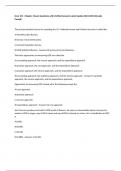Econ 101 - Chapter 2 Exam Questions with Verified Answers Latest Update 2024-2025 (Already
Passed)
The principal printed source for reporting the U.S. National Income and Product Accounts is called the
A) Monthly Labor Review.
B) Survey of Current Business.
C) Current Population Survey.
D) GDP Statistical Review - Answers B) Survey of Current Business.
The three approaches to measuring GDP are called the
A) accounting approach, the income approach, and the expenditure approach.
B) product approach, the cost approach, and the expenditure approach.
C) product approach, the income approach, and the expenditure approach.
D) accounting approach, the statistical approach, and the income approach - Answers C) product
approach, the income approach, and the expenditure approach.
Approaches to measuring GDP include all of the following except the
A) cost approach.
B) product approach.
C) income approach.
D) expenditure approach - Answers A) cost approach.
Jim's Nursery produces and sells $1100 worth of flowers. Jim uses no intermediate inputs. He pays his
workers $700 in wages, pays $100 in taxes and pays $200 in interest on a loan. Jim's contribution to GDP
is
A) $900.
B) $1000.
C) $1100.
D) $1800 - Answers C) $1100.
,Jim's Nursery produces and sells $1100 worth of flowers. Jim uses no intermediate inputs. He pays his
workers $700 in wages, pays $100 in taxes and pays $200 in interest on a loan. Jim's profit is
A) $100.
B) $200.
C) $400.
D) $800 - Answers A) $100.
Acme Steel Co. produces 1000 tons of steel. Steel sells for $30 per ton. Acme pays wages of $10,000.
Acme buys $15,000 worth of coal, which is needed to produce the steel. Acme pays $2,000 in taxes.
Acme's contribution to GDP is
A) $15,000.
B) $20,000.
C) $30,000.
D) $45,000 - Answers A) $15,000.
Acme Steel Co. produces 1000 tons of steel. Steel sells for $30 per ton. Acme pays wages of $10,000.
Acme buys $15,000 worth of coal, which is needed to produce the steel. Acme pays $2,000 in taxes.
Acme's profit is
A) $0.
B) $2,000.
C) $3,000.
D) $15,000 - Answers C) $3,000.
Pamela's bakery produces 500 loaves of bread in a given year. Pamela pays $100 for flour and yeast,
pays $600 in wages, pays $50 in interest on an existing loan, and pays $100 in taxes to the government.
One of Pamela's bread slicing machines, which cost $75 each, wears out over the course of the year and
must be scrapped. Pamela's profit for the year equals $75. Pamela's bread, therefore, sells for
A) $0.50 per loaf.
B) $1.00 per loaf.
C) $2.00 per loaf.
D) cannot tell, insufficient information - Answers C) $2.00 per loaf.
, Suppose we have the following information about a car manufacturer: car sales $1000M, steal
purchases $600M, wages $300M, interest on business loans $50M, and profits $50M. What is its
contribution to GDP using the product approach?
A) $1000M
B) $600M
C) $400M
D) $350M - Answers C) $400M
We know the following about a tie manufacturer: tie sales $1,300, cotton purchases $750, wages $400,
interest on business loans $100, and profits $50. What is the contribution to GDP of this producer using
the income approach?
A) $550
B) $500
C) $450
D) $400 - Answers A) $550
You are a baker. You paid $150K in wages, $50K for dough, $20K for power, $5K in interest for a business
loan, $25K in taxes, and made a profit of $10K. How much did you contribution to GDP using the product
approach?
A) $80K
B) $85K
C) $190K
D) $260K - Answers C) $190K
We learn the following about a ski resort: ticket sales $100M, snow making expenses $70M, wages
$20M, interest on business loans $5M, and profits $5M. What is the contribution to GDP using the
product approach?
A) $70M
B) $80M
C) $95M
D) $100M - Answers A) $70M




